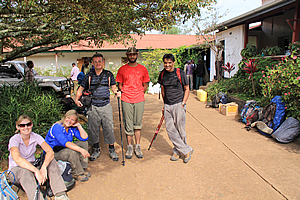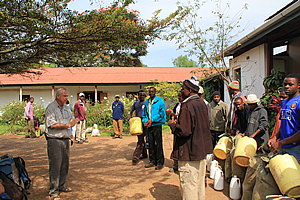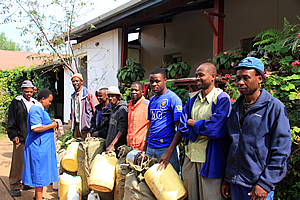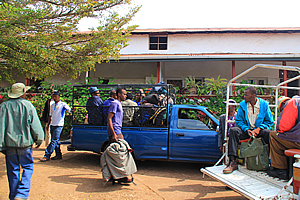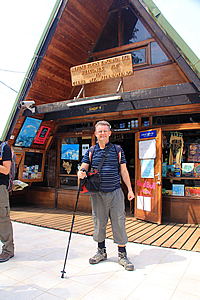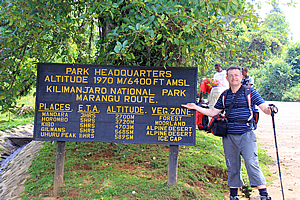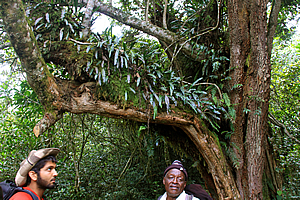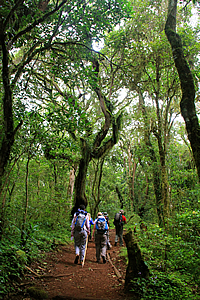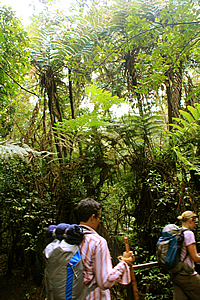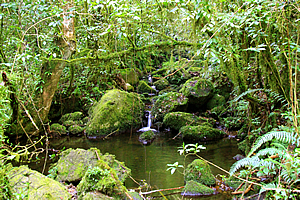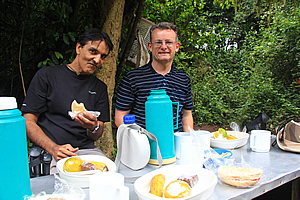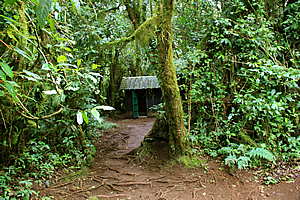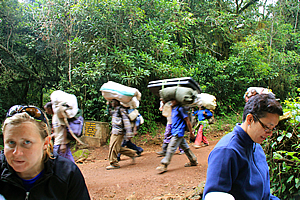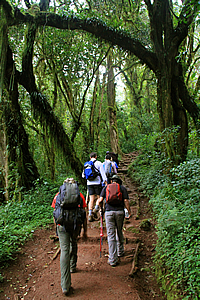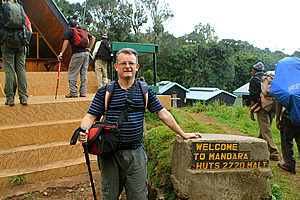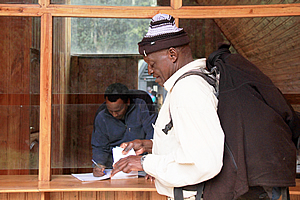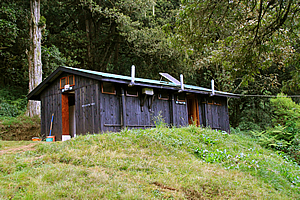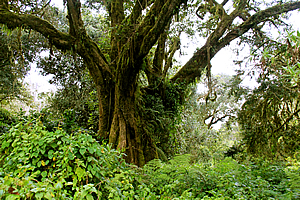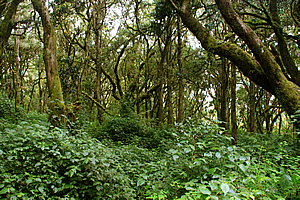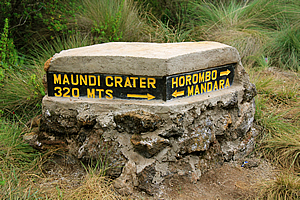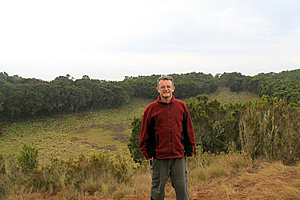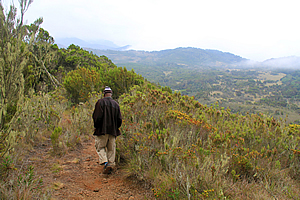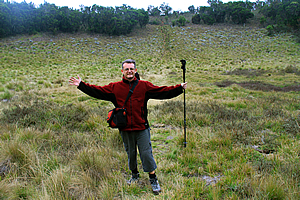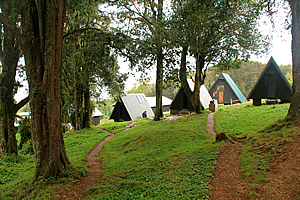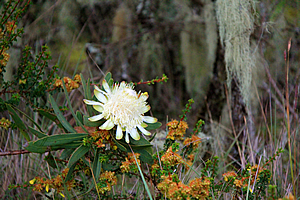|
||||||||||||||||||||||||||||||||||||||||||||||||||||||||
|
||||||||||||||||||||||||||||||||||||||||||||||||||||||||
Home > Treks > Outside Australasia > Mount Kilimanjaro > 3 |
||||||||||||||||||||||||||||||||||||||||||||||||||||||||
|
||||||||||||||||||||||||||||||||||||||||||||||||||||||||
Introduction to today's journeyI'm always astonished by a forest. It makes me realise that the fantasy of nature is much larger than my own fantasy. I still have things to learn. - Gunter Grass. Today's trek starts from the top of Marangu village heading up the mountain through cloud forest until reaching the bushline at Marangu Hut. From there we explore Maundi Crater. Today's JourneyDistance trekked today: 8 kilometres. Total distance trekked to date: 12 kilometres. ALTHOUGH we had our briefing for the climb last night, none of our guides or porters had been present. We were due to meet them this morning. I re-joined our group at breakfast following a very good night's sleep. The sky was again too hazy and cloudy to see the mountain, and I was beginning to think that perhaps it is always surrounded by cloud, as many mountains are. After all most mountains are cloud magnets.
After breakfast, I finished packing and brought my main backpack to the courtyard outside reception. A row of backpacks already lay along one of the walls, and one of the porters (I assumed he was one of our porters) told me to put my backpack there as well. I returned to my room to pick up my valuables. This included my netbook computer, guessing I won’t have any time to write up the mountain. There was also the bag containing the telephoto lens. From experience I never take zoom shots when I am up mountains, plus there wasn’t much chance of seeing wildlife, so there was no point in me lugging such a heavy lens. There was room in that bag for me to put other valuables that I didn’t need up the mountain. I took these to reception and Sarah took them and placed them in a white money bag. Fortunately everything fitted into the one bag. On my way back to my room I stopped at the shop and bought some headache tablets and a couple of chocolate energy bars. There is surely nothing more I would need now. Again I returned to my room this time to pick up my daypack, which had my water and other essentials, my camera bag, and also the sack full of stuff that I won’t be taking up the mountain. I walked across the courtyard to the storage room where the lady who inspected my gear yesterday was standing hunched over and guarding the door. She took my sack and placed it on a shelf. I returned to the courtyard to where the others were waiting. Vicky was showing off her new high tech clothing she had bought especially for the climb. It was all too flash and brand new for my liking – just like my boots. No doubt they will be trashed by the time we return. Ashley was having problems extending her walking poles. She had bought them before the trip, but to date she had never tried them. I attempted to extend them, but they were fast stuck. I didn’t want to risk breaking them, so she took them to a few other people to try, and finally Desmond was successful in getting them extended. Perhaps he has done this many times before.
I had a discussion with the rest of the group about how the porters were going to carry our bags, as most of us had ergonomic backpacks. A couple of us stored stuff in sacks, so that would give the porter no choice but to use our packs. Others in the group decided that because most of the locals don’t seem to wear deodorant, they didn’t want their bags to smell too much, so they put their bags into storage and let the porters carry the sacks instead. I really didn’t care. I was happy for my porter to wear my backpack, so long as everything got to each of the huts during the trip. I would rather my porter carried my ergonomic and weather proof backpack than to arrive to a soggy sack full of my gear each evening. Unlike the rest of us, Jono decided he was macho and insisted on carrying his own backpack. The bag appeared quite small, but would have had a fair bit of weight in it, perhaps fifteen kilogrammes. His personal porter will have an easy job up the mountain, with nothing to carry until Jono decides to give it up (or is perhaps convinced to give it up). Not only was he completely confident about reaching the summit, he was adamant on taking all his gear up to the base camp at Kibo Hut. We thought his cockiness was borderline insane, but that was his decision. He started talking about the people who only make it up to Gillman’s Point, and how they are so crazy to not go onto the summit after getting so close. The thought was hilarious to him. Deep down I realised if anyone in our group wasn’t going to make it to the summit, it was going to be him. Young and cocky is a lethal mix when scaling a major mountain.
Amongst the group of porters was a man who appeared much older than the rest of them. He was rather overweight though reasonably well built. Despite this he clearly seemed to be the one in command in amongst the porters. He was wearing a woollen hat. He led us to a table with plastic lunch boxes each containing food. We each took one lunch box and packed into the tops of our day packs. Finally the porters were ready, having packed all the food. Desmond arrived calling everyone together to do some introductions (finally). Firstly he introduced us to the overweight man with the woollen hat. Jaseri was a 67 year old local who was one of the most experienced guides on the mountain. He has been guiding on the mountain since he was a teenager over forty years ago, before I was born. We had already observed he was the bossy one ordering everyone else around. He was our chief guide responsible for getting us to the top and back again. Assisting Jaseri were two assistant guides Azaan and Imira, a cook Hekima, and seventeen porters. We were then introduced to our porters. My porter was Hasani. He appeared incredibly fit, even more so than the other porters. He was quite young, and would easily be able to handle carrying my backpack containing all my bedding, warm clothes, and my tripod. I had guessed he would have been allocated my bag as it appeared to be the heaviest and he appeared to be the fittest. Perhaps it was my camera tripod mounted to the side that had scared everyone else. I realised I wouldn’t be seeing much of Hasani during the trip. That was a little sad as I knew he would always be there for me supporting me by carrying all my gear up and down this enormous mountain. Others in my group were equally appreciative off their porters. This was all except Jono who spent the time with his porter insisting he carry his own fifteen kilogramme backpack up the mountain. This meant his porter didn’t need to carry anything at all, but I imagined this meant he would have to carry some of the food and cooking equipment up the mountain. I’m sure Hasani would have envied this porter.
A small white minivan arrived, and we started to pile into it. There were also two utilities with low caged backs. One was white and the other bright blue. Our porters sat in the tray of each ute in amongst the rabble of our packs. This was going to be their transport to the start of the track. Once we were all inside our van, Jaseri climbed into the front seat beside the driver and we took off out of the hotel. Once on the main road we followed the direction I had taken with Gary and Dawn for the first part of the waterfall walk yesterday. We continued following the road, passing several small villages. The road became narrower and the terrain became more difficult as we quickly gained altitude on our approach towards the start of the track. I recalled from past high altitude treks that the best way to acclimatise on a climb was to ascend slowly. This has been the case last night at the briefing for the climb that was going to be by far my highest. About ten minutes after leaving the Marangu Hotel following the narrow winding road up the mountain, we reached a large car park where the van stopped. We piled out carrying our bags with us across the car park to a low set of stairs at the base of a wooden platform with a couple of large two storey A-framed wooden buildings.
We signed in at the larger A-framed building. It was definitely a chalet style building reminding me of my own house back in Brisbane. It took quite a while for us all to be signed in though, signing away our names, leaders and passport numbers. Two local men were behind the counter, one taking our passports and photocopying them and the other making sure we were filling in the intentions book. I was one of the first to sign in, so spent the time whilst waiting setting my walking pole to an optimum height for the long uphill ahead – all three and a half days of uphill covering 3925 metres of altitude gain before I would need to lengthen the pole at the summit for the long descent. I waited in nervous anticipation for the others to sign in. To me this was like doing Mount Kinabalu last year, venturing into new altitudes. This time though I was heading into very dangerously high altitude. Once we were all signed in, we walked a few metres to a small service road where there was a large sign indicating the different legs of the trail.
There is an urban legend that the Marangu Route is said to be the easy way up the mountain. Perhaps it is because this route sees more people than the other four routes put together. Perhaps it is because it is the only route where there are huts to stay in every night. Perhaps it is because it is the only route where you are allowed to complete the entire trek in five days. For whatever reason it is considered the easy route, it also has the highest failure rate. Despite the urban legend, this route is technically just as difficult as any other route. This is also the only route where groups complete it in five days. For those of us doing it in the short five days, it is actually more dangerous due to the lack of time you get to acclimatise to the thinning air.
Des had mentioned all of this at the briefing last night, but now it was starting to sink in. Here I was at the base of the world’s tallest free standing mountain, one of the seven summits, and the fifth most prominent mountain the world, about to venture into unknown altitudes on the route and itinerary with the highest failure rate. We all posed beside the sign for photos for a few minutes before Jaseri led us through a small open gate to the start of the track. We all followed him, with the two assistant guides wearing their backpacks at the rear. The road was for the porters and any service vehicles heading up the mountain. Jaseri led the way wearing his woollen hat, with Vicky directly behind and Gary and Dawn behind them. I was next with Ashley following me and the Canadian Indians behind her. Jono was wearing a cowboy hat and to my surprise he was spitting on a very regular basis. At the back of the group were our assistant guides Azaan and Imara each carrying a fairly sizable backpack. We commenced the epic hike walking at a very slow pace. Jaseri deliberately set the pace telling us every five minute “polé polé” (pronounced pollay pollay). I remembered from last night’s briefing that a slow ascent was essential in minimising the symptoms of altitude sickness.
|
||||||||||||||||||||||||||||||||||||||||||||||||||||||||
Walking through the forest |
I recalled we had the same thing at the start of Mount Kinabalu. Though rather than polé polé it was pelan pelan. In whatever language, it was universally accepted that high mountains required respect by ascending slowly, slowly. Anyway I was happy to oblige at Jaseri’s pace although I think the others thought he was taking it too slowly.
My legs suddenly felt surprisingly stiff as we passed through the thick forest. Then I realised the stiffness was from the intense walk up and down the gully from the waterfall yesterday. The stiffness was quickly starting to increase. Although I had a fitness trainer over the past year and a half, I had stopped going about a month earlier when I had accidentally put my back out a little My back had quickly recovered, but I never picked my fitness routine up again in fear of any further injury. I was now paying for that decision.
Small cascading stream |
I was very careful to let my back rest for about two weeks before the start of the trip. Unfortunately during that time my fitness had decreased significantly and my weight had suddenly increased. Since arriving in Africa I had been eating a lot more than usual adding to the weight I was putting on. Now I had nowhere near the fitness that I had last year when I had done the Inca Trail or Mount Kinabalu.
Additional to this my new boots felt a little stiff. My old ones had worn out from my past trips, so I had bought some more of the same size. Well I had thought they were the same size. Now it seemed that these were slightly smaller than the other pair. Hopefully they weren’t going to cause me any discomfort when it really mattered.
Despite these minor ailments I still had the willpower to get to the top.
We plodded on saying polé polé. Now we were hiking through the amazing cloud forest, with gnarled trees with orange bark mostly covered in moss and epiphytic ferns. The trunks of the trees were smothered with broadleaf climbing plants growing up them.
There were a lot of tiny flowers beside the track. There were tiny white bell flowers and little violets of several colours from white to purple. The track started a gentle rise roughly following the top of a low ridge. The trees became taller and very magnificent with the occasional grove of tree ferns.
We crossed a small wooden bridge over a small stream full of pools surrounded by moss covered rocks under large tree ferns. This was quickly followed by a boardwalk to a small junction, where Jaseri led us along the side track to the right.
Lunch! |
The side track crossed a small bridge before turning and rising to the service road. Here we would have been about two thousand metres above sea level. We crossed over the dirt road to a large aluminium picnic table where we had lunch. Many porters were walking in either direction along the road, along with the occasional service vehicle slowly driving past. Most of the porters were carrying their sacks of gear on their heads. Even the ones wearing backpacks were carrying them on their heads. To me it seemed completely weird, but they all seemed reasonably comfortable. Perhaps their skulls are thicker than ours.
Loos hidden in the forest |
Behind us nestled deep in the thick forest was a crude toilet block, which I used. In front of it were several sacks hanging off the trees for us to put our rubbish in, and no doubt for porters to carry down the mountain.
I pulled out the lunch box that Jaseri had given us this morning. The oranges were green and rather inedible I thought. Obviously they like them sour here. The sandwiches were nice though.
Porters passing us at lunch |
Once rested with lunch eaten we returned down the short trail to the main track, with a sign saying that Mandara was about an hour and a half away. We must be more than half way up there already, though the track became steeper from here onwards. My legs were feeling stiff again still recovering from yesterday’s climb into and out of the waterfall.
As soon as we entered the forest, we saw a couple of monkeys lurking deep in the forest. I didn’t get a good picture of them though as it was quite dark in there and the monkeys were very concealed keeping their distance from the strange travellers in their midst. The one that I did see had a very flat face with a white patch over its nose and mouth and chin. Otherwise it was a mousy grey colour. We saw another one in the trees in the distance. I think it was the same variety. This one had a very long white bushy tail.
Continuing through the forest |
The undergrowth changed to a ferny cover. There was a small waterfall through the trees. The trees themselves were now covered in Spanish moss and starting to get smaller with approaching the bush line. We passed another entrance to the end of the service road, so now we were sharing the track with the porters. That being said all of our porters had well and truly passed us by now. The ones who were passing us were belonged to groups who would have departed the Marangu gate much later than our group. One thing these porters had in common was they clearly had no concept of polé polé. Then again they weren't going all the way to the summit, so the ascent wasn't going to be as extreme.
I had a clear goal of going all the way to the summit. I wasn't taking any chances. To survive this climb I was more than happy to go polé polé!
The Marangu Route is the only trail up the mountain that has huts. All of the other routes only had campsites. I figured we were pretty close to the first of these huts.
Arriving at Mandara |
Suddenly the forest cleared ahead of us. The trees by now were pretty short and the undergrowth was mostly broadleaf climbers and the occasional fern. About a minute passed before I could see A-framed buildings in the clearing. The pace quickened as we took the final steps towards our first destination.
A rectangular concrete block had a plaque on it saying “Welcome to Mandara Huts 2720 MALT”. We were there – first leg conquered!
Some sandstone tiled steps led straight up to one of the many A-framed huts where a man sat signing everyone in. Jaseri led us there and we all signed in, to say we had successfully completed the first leg of the trek.
Jaseri signing in |
Once signed in, we walked past an even larger A-framed hut to some much smaller ones just beyond it in front of the forest. The large hut was the communal dining hall. Two of the small huts were going to be our accommodation. Jaseri gave us two sets of keys. I went with the two Indian guys to one hut, and the others went in a closer hut next door.
The hut had four beds. There was one either side of the door in the entrance. Then there was a bunk of two beds at the back. One of the beds was at ground level at the same low height of the other two beds, and the other a little over a metre above. Jono wanted the top bunk, so we let him have it. Mark wanted the bunk beside the door, and I decided to have the bunk behind the door where there would be the most privacy.
Grotty toilets |
Once settled, I needed to use the loo. There was a toilet block behind the dining area, so I went there. It was a conventional shaped building with derelict greyed wooden walls all around. The front door was for women and the men’s entrance was half way to the back. I entered the men’s and found it was rather grubby in there. All the toilets were squat bowls, and they were all very dirty.
Once settled, we went to the dining hall where we had the first table inside the door. There were four large tables, each made of wood. There were two on either side of the room with long pews like seats on either side. They must have taken a massive effort to lug all the way up here even just from the service road.
Ancient tree |
We were served a big plate of popcorn and another of muffins. There was tea, coffee, and hot chocolate. They produced four aqua coloured thermos flasks. Two had water and two had dilute milk powder, all boiling hot. We had a well-deserved afternoon tea.
Once finished afternoon tea, we set off along the track beyond the huts. The forest of gnarly trees quickly closed in, leaving the huts in the eerie distance.
Jono and I stayed a little behind the group to photograph the forest. Jono was spitting quite a lot still. I thought perhaps that may be a really bad habit that he has but I didn’t mention anything.
Cloud forest above the hut |
The trees were amazing. They were obviously many hundreds of years old and contorted in all sorts of directions. They were like the giant cloud forest trees I had seen in sheltered gullies in different parts of New Zealand and on Mount Kinabalu. Epiphytes hung from the branch junctions and Spanish moss draped over the branches accentuating their antiquity. The ground was covered with thick layers of climbing broadleaf plants to about one or two metres thick making it impenetrable once off the track.
The track itself was a fine gravel of very rough jasper coloured scoria. There were monkeys in the trees, but too distant to see clearly or photograph.
Within five minutes we were above the forest, and surrounded by scrubby subalpine heath bush scattered and standing three or four metres high. Fortunately my legs weren’t stiff any more.
Sign at the junction |
We reached a junction. The main track had signs pointing to Mandara, and Horombo – the next hut. A side track had the sign pointing to Maundi Crater, just three hundred and twenty metres away. This was the direction we took.
The scrub thinned as we walked through the grassy heath. A couple of minutes later we reached the crater around a fairly large depression. This was a crater, very similar in appearance to the ones in Auckland, New Zealand, but not as deep.
Maundi Crater |
Jaseri explained this was one of the side craters of the mountain. People who come on day walks up the mountain only go this far. The crater had grass in the bottom and scrub around the ridge. It was probably grass down the bottom because a lot of water accumulates here during the rainy season.
The sky was overcast with medium level cloud perhaps two kilometres above us. The terrain was surprisingly dull, with a gentle slope heading up towards a huge domed hill beyond us. No doubt we will be heading up towards there tomorrow. Below us the mountain divided into numerous bluffs and ridges, but again it wasn’t particularly interesting. It wasn’t like the steep sided volcanoes of New Zealand.
Walking around Maundi Crater |
We followed a track running anticlockwise around the top of Maundi Crater, stopping to photograph the withered scrub covered in Spanish moss. There were some interesting subalpine flowers in amongst the grass.
We were on the far side of the crater when we turned and followed the track descending straight down the side into the bowl bottom. The bottom appeared to be swampy, but it had fortunately dried out. We posed in the middle before starting the climb to the top back where we first saw the crater.
In the middle of the crater |
Drizzle started falling as we reached the top of the crater, so we walked back fairly quickly along the track. The drizzle had stopped falling by the time we returned to the forest. A couple of minutes later I saw the welcome sight of the A-framed huts again.
Upon our return from Maundi Crater, I arrived at our hut. The door was open. After a little detective work we realised that Jono, who was last to leave the room, had left the door unlocked. Fortunately there was nothing missing.
Mandara Huts |
Once back at the huts, we dropped our bags off in our rooms and returned to the dining hut and sat around our table with the multi coloured table cloth. We chatted for a while as the porters prepared our dinner. Finally they came in bringing plates – ceramic plates – with tomato soup and fresh bread. All the other treks I had done in the past had plastic or aluminium plates. I was very impressed with eating from ceramic plates up here on the mountain.
Then they brought in large metal platters of roasted potatoes and another one of vegetables. Then there was another plate containing roasted chicken. The food was very nice. We thanked them with a new Swahili phrase Jaseri had just taught us – Asante sana – thank you very much.
Flower at Maundy Crater |
Everyone else was complaining of a tingling feeling in their fingers. Vicky mentioned this was one of the side effects of Diamox, which everyone else was on. I had no side effects at all being on the Gingko Biloba. The natural remedies were working to my advantage.
The sky grew dark as we ate. There was plastic tubing for wires and light bulb sockets, but no lights. Obviously any power system that had been set up here was no longer working.
With no light apart from our head lamps, there was little to do, so we all went off to bed.
The air outside was very cold now, perhaps about ten degrees. We hurried into our huts and crawled into our sleeping bags after brushing teeth outside hearing monkeys foraging unseen nearby in the trees. Fortunately the mattress on the floor was quite comfortable, so I was happy to be settled in. My legs were now very stiff still from yesterday’s hike to the waterfall. Hopefully they won’t be too stiff tomorrow as we have a thousand metres of climbing to do.
|
This was now the first time that I had a decent chance to talk with Mark and Jono. Mark mentioned he has a software sales company and obviously doing very well. He had arrived in Canada as a young man and started off getting a commission-only job and had done very well with that as he loved meeting people. He had built that into a very successful business.
We talked about some of the trips we have done in the past, and interestingly we had all done the Inca trail. They had done it about seven years ago when Jono was quite young. He couldn’t remember much, but his dad had remembered Jono hadn’t moaned at all during the hike. His daughter had been quite a handful though, and it seemed to be a good thing that she hadn’t come on this trip pulling out at the very last moment.
Mark was obviously one of those people who couldn’t stop talking. We then talked about science fiction, continuing on with a discussion that we had at dinner. He mentioned the Dune series, and that I should read the original ones. I made a mental note of that although I don’t read much these days. Dune is apparently about the world in sixty thousand years’ time, and how things are very different then, and how humans have evolved. It sounded very interesting. No wonder he was so good with sales.
Finally we stopped talking and went to sleep.
| Home | Photography | Diary | Travels | Treks | |
© 2001-2020 walkaboutjeff.com - Copyright - Disclaimer - Who is Walkabout Jeff? |

